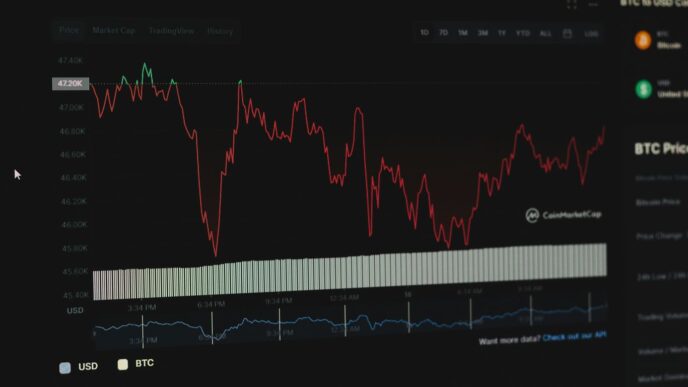Looking to make your blog a go-to spot in 2025? Figuring out what people actually want to read is half the battle. We all want more eyes on our posts, right? It’s not just about writing; it’s about writing what’s hot. This year, let’s focus on trending blog topics that grab attention and keep readers coming back. We’ve put together some ideas that should help boost your engagement and make your blog stand out.
Key Takeaways
- Create practical how-to guides and simple beginner’s guides to help your audience solve problems and understand complex subjects easily.
- Stay current by writing about industry news, trends, and timely seasonal or holiday topics that grab immediate attention.
- Build trust by sharing case studies, success stories, and interviewing experts to show your knowledge and unique perspective.
- Make your content easy to digest with listicles and visually appealing infographics that readers can quickly understand and share.
- Consider opinion pieces on current issues to spark discussion and reviews of products that help readers make smart choices.
Leveraging Foundational Content For Maximum Reach
Foundational content is the bedrock of a strong online presence. It’s the stuff that sticks around, consistently drawing in readers and establishing your site as a go-to resource. Think of it as the evergreen trees in your content forest – always green, always relevant. This type of content doesn’t rely on fleeting trends; instead, it addresses core needs and questions that your audience will have, regardless of the current buzz.
How-To Guides And Tutorials For Actionable Insights
People often turn to the internet when they need to figure something out. That’s where how-to guides and tutorials shine. They provide step-by-step instructions that help readers accomplish a specific task. Whether it’s fixing a leaky faucet, learning a new software feature, or mastering a cooking technique, a well-made guide can be incredibly satisfying for the reader. The key is to be clear, concise, and thorough. Break down complex processes into manageable steps. Use visuals if possible, like screenshots or simple diagrams, to illustrate each stage. Don’t assume your reader knows anything; start from the basics and build up. This approach builds trust and positions you as someone who can genuinely help.
Beginner’s Guides To Simplify Complex Topics
Some subjects can seem really intimidating at first glance. Think about topics like cryptocurrency, quantum physics, or even advanced gardening. A beginner’s guide acts as a friendly introduction, breaking down these complex subjects into digestible pieces. The goal here is to demystify the topic, making it accessible to someone with no prior knowledge. You want to explain the ‘what,’ ‘why,’ and ‘how’ in simple terms. Avoid jargon where you can, or explain it clearly if it’s unavoidable. Think about the questions someone completely new to the subject might ask and answer them directly. This kind of content is fantastic for attracting new audiences who are curious but perhaps a little hesitant to dive in. It’s a great way to start building your blog content strategy.
In-Depth Product Reviews For Informed Decisions
When people are considering a purchase, they want to know what they’re getting into. In-depth product reviews offer a detailed look at a product or service, going beyond just listing features. Talk about the pros and cons from a user’s perspective. What’s the real-world experience like? How does it perform over time? Consider including:
- Setup and Ease of Use: How simple is it to get started?
- Performance: Does it do what it claims, and how well?
- Durability and Build Quality: Will it last?
- Value for Money: Is it worth the price tag?
Honest, detailed reviews build credibility. If you can show you’ve really tested the product and are giving a balanced view, readers will trust your recommendations. This can be particularly effective for niche products or services where detailed information is scarce.
Harnessing Timeliness And Relevance

Staying on top of what’s happening right now is a big deal for keeping your blog interesting. People want to know about the latest stuff, and that’s why covering industry news and trends is a smart move. It’s how you show readers you’re in the know and that your blog is a place to get current information.
Industry News and Trends for Current Awareness
Think about it: the world moves fast. New technologies pop up, markets shift, and what was cutting-edge yesterday might be old news tomorrow. Your readers know this, and they’re looking for a reliable source to keep them updated. By regularly sharing and discussing industry news, you become that go-to source. It’s not just about reporting facts; it’s about offering your take on what these changes mean for your audience. This positions you as someone who understands the bigger picture, not just the day-to-day.
To do this well, you need to keep your eyes and ears open. Subscribe to industry newsletters, follow the big players on social media, and maybe even use tools that gather news for you. For example, the way we consume content is changing with things like voice search and faster internet speeds. AI is also playing a bigger role in making things personal for users. These are the kinds of shifts that matter. When you talk about these things, you’re not just sharing news; you’re helping your readers understand how their world is changing. This kind of content keeps people coming back because they know they’ll get the latest insights. It’s a great way to attract an informed audience and show you’re a leader in your field. Check out some of the latest developments in content marketing success.
Seasonal and Holiday Content for Peak Interest
Everyone loves a good holiday or a timely event. Tying your content to the calendar can bring in a lot of attention. Think about the upcoming holidays or even just the change of seasons. What are people thinking about or planning for during these times? For instance, as winter approaches, people might be looking for tips on staying warm, holiday gift ideas, or planning for end-of-year events. Your blog can tap into these interests.
Here are a few ideas:
- Holiday Gift Guides: Curate lists of gift ideas related to your niche. This is super helpful for readers and can drive traffic.
- Seasonal How-Tos: If you’re in the cooking niche, share recipes for holiday meals. If you’re in fitness, offer tips for staying active during colder months.
- Event Recaps or Previews: Cover local or industry events, or create content that gets people excited for upcoming happenings.
This kind of content feels relevant and timely. It shows you understand what’s on your readers’ minds right now, making your blog feel more connected to their lives.
Controversial Topics and Opinion Pieces for Discussion
Sometimes, the best way to get people talking is to tackle a topic that sparks debate. Sharing your well-reasoned opinions on controversial subjects can really get your audience engaged. It shows you’re not afraid to take a stand and encourages readers to share their own thoughts. This can lead to lively comment sections and a more active community around your blog.
When you do this, it’s important to be respectful and back up your points. You don’t want to just stir up trouble; you want to start a meaningful conversation. Presenting different sides of an issue or explaining why you believe what you do can be very effective. It’s a way to show personality and build a stronger connection with your readers by sharing your unique perspective. This approach can make your blog stand out and attract readers who appreciate a blog that isn’t afraid to explore complex issues.
Showcasing Value And Expertise
Showing people what you’re good at and why they should trust you is a big part of getting them to stick around. It’s not just about saying you’re the best; it’s about proving it with real examples and solid information. This is where you build that trust that makes people come back for more.
Case Studies And Success Stories For Credibility
Think about telling a story about how you helped someone. A case study is basically a detailed look at a problem a customer had and how your product or service fixed it. It’s like showing before and after pictures, but with words and data. People want to see that what you offer actually works for others, especially if they’re facing similar issues. It makes your claims feel real.
For example, you could write about a client who was struggling with low website traffic. You’d explain their situation, what you did (like improving their SEO or creating new content), and then show the results – maybe their traffic went up by 50% in three months. This kind of story is way more convincing than just saying, “We’re great at SEO.”
Here’s a quick look at what makes a good case study:
- The Setup: Describe the customer’s problem clearly. What were they trying to achieve, and what was stopping them?
- The Solution: Explain exactly what you did. Be specific about the steps you took and why.
- The Results: Show the positive outcomes. Use numbers and data whenever possible to make it concrete. Did sales increase? Did costs go down? Was customer satisfaction better?
Interviews With Experts For Authoritative Opinions
Talking to people who really know their stuff in your field can make your blog look super smart. When you interview an expert, you’re not just getting their opinions; you’re borrowing some of their authority. It’s like having a celebrity endorsement, but for knowledge.
These interviews can take many forms. You might do a Q&A session where you ask them tough questions, or maybe a more casual chat about their experiences. The key is to pick someone whose insights will genuinely interest your audience and add something new to the conversation. It shows you’re connected and serious about the topic.
Consider these points when planning an expert interview:
- Choose Wisely: Select an expert whose field directly relates to your blog’s focus and whose opinions are respected.
- Prepare Your Questions: Don’t just wing it. Have a list of thoughtful questions ready that will get interesting answers.
- Promote It: Let your audience know who you’re talking to and why they should tune in. This builds anticipation.
Thought Leadership Content For Authority Building
This is where you share your unique ideas and perspectives. It’s not about repeating what everyone else is saying. Instead, you’re showing how you think differently about your industry. This kind of content helps position you as a go-to source for original thinking.
When you put out content that makes people stop and think, you start to build a reputation. It could be an opinion piece on a new trend, a prediction about the future, or a breakdown of a complex issue from your specific viewpoint. It takes a bit of courage to put your own ideas out there, but it’s how you stand out.
Here’s what makes good thought leadership:
- Originality: Offer a fresh take or a new angle on a topic.
- Insight: Go beyond surface-level observations; provide deeper analysis.
- Clarity: Present your ideas in a way that’s easy for your audience to grasp, even if the topic is complex.
Structuring Content For Reader Experience

Making your blog posts easy to read is super important if you want people to stick around. Nobody likes staring at a giant wall of text, right? It’s all about making it simple for them to find what they’re looking for and digest the information without feeling overwhelmed. Think about how you scan articles online – you’re probably looking for headings, bullet points, or bolded bits to get the gist. We should do the same for our readers.
Listicles And Roundups For Easy Consumption
Listicles, or articles structured as lists, are fantastic for breaking down information into bite-sized chunks. They’re super scannable and give readers a clear overview of topics. For example, a post titled “7 Ways to Improve Your Home Office Setup” is instantly understandable. Readers know exactly what they’re getting into, and it feels less daunting than a long, narrative piece. This format is great for quick tips, step-by-step instructions, or collections of resources. It’s a go-to for getting information across efficiently. You can even use a table to compare different options if you’re reviewing products or services:
| Feature | Product A | Product B |
|---|---|---|
| Battery Life | 10 hours | 15 hours |
| Screen Size | 13 inch | 14 inch |
| Price | $800 | $1200 |
Leveraging Infographics For Visual Appeal
Sometimes, words just don’t cut it. That’s where infographics come in. They take complex data or processes and turn them into something visually engaging and easy to understand. Think charts, graphs, icons, and minimal text. They’re perfect for showing statistics, timelines, or how something works. People tend to remember visual information better, too. So, if you’ve got a lot of data to share, turning it into an infographic can make a huge difference in how well your audience grasps it. It’s a great way to make your content pop and keep readers on the page longer. For anyone looking to get started with blogging, understanding these structural elements is key to starting a blog effectively.
Here’s a quick rundown of why these structures work:
- Listicles: Make information digestible and scannable.
- Roundups: Compile resources or ideas efficiently.
- Infographics: Simplify complex data and boost retention.
By using these formats, you’re not just writing content; you’re designing an experience for your reader that’s clear, engaging, and helpful.
Wrapping It Up: Your 2025 Content Game Plan
So, we’ve gone over a bunch of ideas for blog topics that people are likely to click on in 2025. It’s all about figuring out what your readers actually want to know and then giving it to them in a way that’s easy to read and understand. Whether you’re explaining how to do something, sharing the latest news, or telling a compelling story, the goal is to get people interested and keep them coming back. Don’t forget to look at what’s working for you already and what your audience is talking about. By mixing and matching these popular topics and paying attention to your readers, you’ll be well on your way to making your blog a go-to spot for great content.
Frequently Asked Questions
How do I pick topics that will get lots of people to read my blog?
To choose topics that attract readers, you need to understand what your audience is interested in. Think about what problems they have or what they want to learn. Look at what’s popular on social media and in your industry’s news. Also, check which of your old posts did really well – those are good clues!
Why are ‘how-to’ guides and tutorials so good for getting readers?
People love ‘how-to’ guides because they offer clear, step-by-step help for specific problems. When you show readers exactly how to do something, they see your blog as a super helpful place and are more likely to come back for more advice.
What makes list posts (like ‘Top 10…’) so popular?
List posts are easy to read and understand quickly. Readers can just skim through them to get the main points without spending a lot of time. This makes them great for people who want information fast and makes them easy to share.
How can I use news and trends in my blog posts?
Keep up with what’s happening in your field. Write about the latest news and trends, but also share your own thoughts on them. This shows you know what you’re talking about and makes your blog a go-to source for current information.
What’s the big deal about using pictures and graphics (like infographics) in blog posts?
Pictures and graphics, like infographics, make information easier to understand and more interesting to look at. They can explain complicated ideas quickly and are more likely to be shared by readers, which brings more people to your blog.
How do interviews with experts help my blog?
Talking to experts gives your blog special insights and makes it seem more trustworthy. When readers see that you can get opinions from well-known people in your field, they pay more attention and see you as an authority too.














